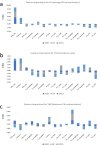Insights from modelling sixteen years of climatic and fumonisin patterns in maize in South Africa
- PMID: 38773169
- PMCID: PMC11109125
- DOI: 10.1038/s41598-024-60904-y
Insights from modelling sixteen years of climatic and fumonisin patterns in maize in South Africa
Abstract
Mycotoxin contamination of agricultural commodities is a global public health problem that has remained elusive to various mitigation approaches, particularly in developing countries. Climate change and its impact exacerbates South Africa's vulnerability to mycotoxin contamination, and significantly threatens its's food systems, public health, and agro-economic development. Herein we analyse sixteen years (2005/2006-2020/2021) of annual national meteorological data on South Africa which reveals both systematic and erratic variability in critical climatic factors known to influence mycotoxin contamination in crops. Within the same study period, data on fumonisin (FB) monitoring show clear climate-dependent trends. The strongest positive warming trend is observed between 2018/2019 and 2019/2020 (0.51 °C/year), and a strong positive correlation is likewise established between FB contamination and temperature (r ranging from 0.6 to 0.9). Four machine learning models, viz support vector machines, eXtreme gradient boosting, random forest, and orthogonal partial least squares, are generalized on the historical data with suitable performance (RMSE as low as 0.00). All the adopted models are able to predict future FB contamination patterns with reasonable precision (R2 ranging from 0.34 to 1.00). The most important model feature for predicting average FB contamination (YA) is the historical pattern of average FB contamination in maize within the region (ΣFBs_avg). The two most significant features in modelling maximum FB contamination (YM) are minimum temperature from the CMIP6 data (Pro_tempMIN) and observed precipitation from the CRU data (O_prep). Our study provides strong evidence of the impact of climate change on FB in South Africa and reiterates the significance of machine learning modelling in predicting mycotoxin contamination in light of changing climatic conditions, which could facilitate early warnings and the adoption of relevant mitigation measures that could help in mycotoxin risk management and control.
Keywords: Climate change; Fumonisin; Machine learning; Mycotoxins; Predictive modelling.
© 2024. The Author(s).
Conflict of interest statement
The authors declare no competing interests.
Figures




Similar articles
-
Fusarium infection of maize and maize-based products and exposure of a rural population to fumonisin B₁ in Limpopo Province, South Africa.Food Addit Contam Part A Chem Anal Control Expo Risk Assess. 2012;29(11):1743-51. doi: 10.1080/19440049.2012.708671. Epub 2012 Sep 11. Food Addit Contam Part A Chem Anal Control Expo Risk Assess. 2012. PMID: 22963721
-
Assessment of mycotoxin risk on corn in the Philippines under current and future climate change conditions.Rev Environ Health. 2015;30(3):135-42. doi: 10.1515/reveh-2015-0019. Rev Environ Health. 2015. PMID: 26351797
-
Rural Subsistence Maize Farming in South Africa: Risk Assessment and Intervention models for Reduction of Exposure to Fumonisin Mycotoxins.Toxins (Basel). 2019 Jun 12;11(6):334. doi: 10.3390/toxins11060334. Toxins (Basel). 2019. PMID: 31212811 Free PMC article. Review.
-
Occurrence of the C-series fumonisins in maize from the former Transkei region of South Africa.Food Addit Contam Part A Chem Anal Control Expo Risk Assess. 2011 Dec;28(12):1712-6. doi: 10.1080/19440049.2011.605773. Epub 2011 Oct 11. Food Addit Contam Part A Chem Anal Control Expo Risk Assess. 2011. PMID: 21988139
-
Mycotoxin contamination of foods in Southern Africa: A 10-year review (2007-2016).Crit Rev Food Sci Nutr. 2019;59(1):43-58. doi: 10.1080/10408398.2017.1357003. Epub 2017 Sep 25. Crit Rev Food Sci Nutr. 2019. PMID: 28799776 Review.
Cited by
-
A Review of the Mycotoxin Family of Fumonisins, Their Biosynthesis, Metabolism, Methods of Detection and Effects on Humans and Animals.Int J Mol Sci. 2024 Dec 28;26(1):184. doi: 10.3390/ijms26010184. Int J Mol Sci. 2024. PMID: 39796041 Free PMC article. Review.
-
Multi-Mycotoxin Contamination in Serbian Maize During 2021-2023: Climatic Influences and Implications for Food and Feed Safety.Toxins (Basel). 2025 May 4;17(5):227. doi: 10.3390/toxins17050227. Toxins (Basel). 2025. PMID: 40423310 Free PMC article.
References
-
- Waśkiewicz A, Beszterda M, Goliński P. Occurrence of fumonisins in food–an interdisciplinary approach to the problem. Food Control. 2012;26:491–499. doi: 10.1016/j.foodcont.2012.02.007. - DOI
MeSH terms
Grants and funding
LinkOut - more resources
Full Text Sources
Medical
Miscellaneous

